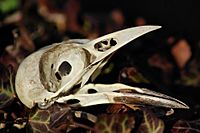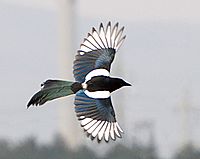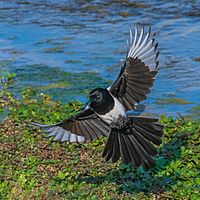Eurasian magpie facts for kids
Quick facts for kids Eurasian magpie |
|
|---|---|
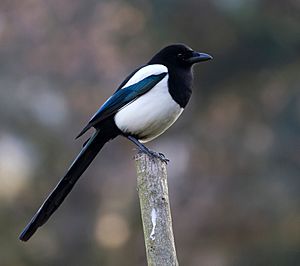 |
|
| A Eurasian magpie in Toulouse, France |
|
| Conservation status | |
| Scientific classification | |
| Genus: |
Pica
|
| Species: |
pica
|
| Subspecies | |
|
See text |
|
 |
|
| Where Eurasian magpies and their different types live around the world | |
| Synonyms | |
|
Corvus pica Linnaeus, 1758 |
|
The Eurasian magpie or common magpie (Pica pica) is a bird that lives and breeds across the northern parts of Eurasia. It belongs to the crow family, which includes crows and ravens. In Europe, when people say "magpie," they usually mean the Eurasian magpie, as it's the most common type there.
Eurasian magpies are considered one of the most intelligent birds. In fact, they are thought to be among the smartest non-human animals! Their brain size, compared to their body, is similar to that of chimpanzees and humans. They are also one of the very few animals, and the only bird, known to pass the mirror test, which shows they can recognize themselves.
Contents
Understanding Magpies: Taxonomy
The magpie was first described and drawn by a Swiss scientist named Conrad Gessner in 1555. Later, in 1758, Carl Linnaeus gave it the scientific name Corvus pica. A French zoologist, Mathurin Jacques Brisson, then moved the magpie to its own group, or genus, called Pica in 1760. The word Pica is the old Latin name for this bird.
For a long time, the Eurasian magpie looked so much like the North American black-billed magpie that people thought they were the same species. However, in 2000, scientists decided they were different species after studying their calls and behavior. They found that the black-billed magpie was more closely related to the yellow-billed magpie in North America than to the Eurasian magpie.
Magpies change slightly depending on where they live across their huge range. Scientists recognize several different types, called subspecies. Here are some of them:
- Northern magpie (P. p. fennorum): Found in northern Scandinavia and northwestern Russia.
- European magpie (P. p. pica): Lives in the British Isles, southern Scandinavia, and across Europe to Russia.
- Iberian magpie (P. p. melanotos): Found in Spain and Portugal.
- Russian magpie (P. p. bactriana): Lives in Siberia, Central Asia, and parts of the Middle East.
- P. p. leucoptera: Found in southeastern Russia and northeastern China.
- Kamchatkan magpie (P. p. camtschatica): Lives in the Russian Far East.
Some magpies that were once thought to be subspecies of the Eurasian magpie are now considered completely separate species. These include the Maghreb magpie in North Africa, the Asir magpie in Saudi Arabia, the Oriental magpie in East Asia, and the black-rumped magpie in west-central China. Scientists use DNA to figure out how these different magpies are related to each other.
Where the Name "Magpie" Comes From
Magpies were originally just called "pies." This word comes from an old root meaning "pointed," probably because of their pointed beak or long tail. The "mag" part was added in the 1500s. It comes from the short name "Margaret," which was a common name for women back then. People thought the magpie's chattering call sounded like a woman talking a lot, so they started calling it the "Mag pie." The word "pied," meaning black and white, also came from the magpie's colors.
What Magpies Look Like
An adult Eurasian magpie is about 44 to 46 centimeters (17 to 18 inches) long, and more than half of that length is its tail! Its wingspan is about 52 to 62 centimeters (20 to 24 inches).
Magpies have shiny black feathers on their head, neck, and chest, which can look green or purple in the light. Their belly and shoulders are pure white. Their wings are black with green or purple shine, and when they fly, you can see white parts on their wing feathers. Their long, graduated tail is black with green and reddish-purple colors. Magpies have black legs and a black beak, and their eyes are dark brown.
Male and female magpies look similar, but females are usually a bit smaller. Their tail feathers are quite long, from 12 to 28 centimeters (5 to 11 inches). Males weigh between 210 and 272 grams (7.4 to 9.6 ounces), while females weigh 182 to 214 grams (6.4 to 7.5 ounces). Young magpies look like adults but are not as shiny, and their tails are much shorter.
Different types of magpies (subspecies) can vary in size, how much white they have on their feathers, and the color of the shine on their black feathers. For example, the Asian type, P. p. bactriana, has more white on its wings and a noticeable white patch on its lower back.
Adult magpies shed all their feathers once a year after breeding, usually from June or July to September or October. Young birds shed some of their body feathers a bit later, but not their wing or tail feathers.
Eurasian magpies have a very distinct call. It sounds like a "chac-chac" or a repeated "chac-chac-chac-chac." Young magpies make a similar sound, but also a sharp "Uik Uik" call, which can sound like a small dog barking. Both adults and young can also make a soft hissing sound.
Where Magpies Live
Magpies live across many parts of Eurasia, from Spain and Ireland in the west all the way to the Kamchatka Peninsula in the east. A closely related bird, the Oriental magpie, was brought to Japan on the island of Kyūshū.
Magpies prefer open areas with scattered trees. You usually won't find them in places with no trees or in very dense forests. However, they can live in large numbers in suburban areas like parks and gardens, and even close to the center of cities.
Most magpies stay in the same area year-round, even in winter. But birds living in the far northern parts of their range, like in Sweden, Finland, and Russia, might move south if the weather gets very harsh.
Magpie Behavior and Life
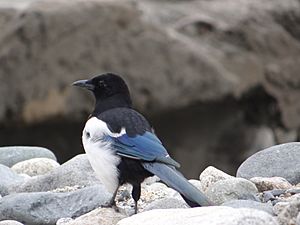
Reproduction and Life Cycle
Some magpies start breeding when they are one year old, while others wait until their second year. They are monogamous, meaning a male and female pair up, and they often stay together for many breeding seasons. They also tend to use the same nesting area year after year.
Mating happens in spring. During courtship, the male magpie will quickly raise and lower his head feathers, fan out his tail, and make soft calls that are different from his usual chatter. He also spreads his shoulder feathers to show off the white patches, hoping to attract a female. Short, bouncy flights and chases often follow this display.
Magpies like to build their large nests in tall trees, attaching them firmly to a central fork in the upper branches. They build a frame of sticks, cementing it with earth and clay, and then line it with fine roots. On top, they build a strong, dome-shaped roof made of thorny branches, with a hidden entrance. These big nests are easy to spot when the leaves fall from the trees. If tall trees are scarce, magpies might build their nests in bushes or hedges.
In Europe, magpies usually lay their eggs in April. A typical clutch has five or six eggs, but sometimes there can be as few as three or as many as ten. The eggs are laid early in the morning, usually one each day. On average, the eggs are about 32.9 by 23 millimeters (1.3 by 0.9 inches) and weigh about 9.9 grams (0.35 ounces). They are usually pale blue-green with small brown spots, but their color and markings can vary a lot.
The female magpie incubates the eggs for 21–22 days, and the male brings her food while she's on the nest. When the chicks hatch, they are altricial, meaning they are born almost naked with their eyes closed. The female keeps them warm for the first 5–10 days, and both parents feed them. At first, the parents eat the chicks' waste, but as the chicks get bigger, they will go to the edge of the nest to poop. The nestlings open their eyes about 7 to 8 days after hatching. Their body feathers start to grow around 8 days, and their main wing feathers appear after 10 days. For several days before they are ready to leave the nest, the chicks will climb around on nearby branches. They leave the nest, or fledge, at around 27 days old. The parents continue to feed the fledglings for several more weeks and protect them from predators, as their flying skills are still developing.
On average, only 3 or 4 chicks from a clutch survive to fledge. Some nests are lost to predators, but a big reason for chicks dying is not enough food. Magpie eggs hatch at different times, so if there isn't enough food, the last chicks to hatch might not survive. Magpies usually only raise one group of chicks per year, unless something happens to their first clutch.
A study in Britain found that only 22% of young magpies survived their first year. For adult magpies, the survival rate was 69% each year, meaning that those who made it past their first year lived for about 3.7 years on average. The oldest recorded magpie lived for 21 years and 8 months!
What Magpies Eat
Magpies are omnivores, which means they eat both plants and animals. Their diet includes young birds and eggs, small mammals, insects, food scraps, dead animals, acorns, grain, and other plant materials.
Magpie Intelligence
The Eurasian magpie is considered one of the smartest birds, and even one of the smartest animals overall. Like other corvids (such as ravens and crows), their brain size compared to their body is similar to that of great apes like chimpanzees and humans. Research suggests that corvids' intelligence is similar to that of great apes in areas like social understanding, problem-solving, flexibility, imagination, and planning for the future.
Magpies have been seen doing complex social rituals, which might even include showing sadness. They are one of the few species that can pass the mirror self-recognition test, which means they can recognize themselves in a mirror. This ability is a sign of high intelligence. The smart abilities of the Eurasian magpie show that intelligence can develop in different ways in different animal groups, like in corvids and in primates.
Magpies use tools, hide and store food for later, remember past events, and use their own experiences to guess what other magpies might do. Another sign of their intelligence is that they cut their food into the right size pieces for their young. In captivity, magpies have been seen counting to get food, copying human voices, and regularly using tools to clean their cages. In the wild, they can work together in groups and use clever strategies when hunting other birds or facing predators.
Magpie Status
The Eurasian magpie lives in a very large area. In Europe alone, there are an estimated 7.5 to 19 million breeding pairs. When you include magpies in other continents, the total population is thought to be between 46 and 228 million birds. The number of magpies in Europe has been steady since 1980, and there's no sign of a serious overall decline. Because of this, the International Union for the Conservation of Nature considers the species to be of Least Concern, meaning it's not currently at risk of extinction.
Magpies and Humans
Traditions and Symbolism

In Europe, magpies have often been seen in a negative light throughout history, mostly because of old beliefs and myths. This is partly because large black birds, like crows and ravens, are often seen as bad in British folklore, while white birds are seen as good.
In European folklore, magpies are linked to many superstitions and are sometimes seen as a sign of bad luck. An old saying from the 1800s says: "A single magpie in spring, foul weather will bring." This belief came from the idea that magpies only forage in pairs when the weather is good. In Scotland, if a magpie is seen near a house window, it's sometimes thought to predict death. In England, some people believe you should greet a single magpie to ward off bad luck, perhaps by saying, "Good morning, Mr Magpie, how are Mrs Magpie and all the other little magpies?"
In Britain and Ireland, there's a popular traditional rhyme called "One for Sorrow." It suggests that seeing magpies can predict the future, depending on how many you see. There are many different versions of this rhyme.
In Italian, British, and French folklore, magpies are believed to love collecting shiny things, especially precious stones or metal objects. The Rossini opera La gazza ladra and The Adventures of Tintin comic The Castafiore Emerald are based on this idea. However, a recent study has shown that this belief might not be true. In countries like Bulgaria, the Czech Republic, Germany, Hungary, Poland, Russia, Slovakia, and Sweden, the magpie is often seen as a thief. In Sweden, it's also linked to witchcraft. In Norway, magpies are thought to be cunning and thievish, but also connected to the "huldra," who are underground people.
Magpies have also been criticized for eating the eggs and young of other birds. However, studies have questioned whether magpies actually cause a decline in songbird populations. One study found "no evidence of any effects of [magpie] predator species on songbird population growth rates." Another study even suggested that songbird populations increased in places where magpie populations were high, meaning magpies don't necessarily harm the overall songbird population.
In Literature
In the 2017 book Fly wings, Fly high, author Catherine Lind tells the true story of a Eurasian magpie named Tiny. Tiny was born with a deformed wing and couldn't fly naturally. The book follows how Tiny survived and learned to live, adapting to his situation. He eventually learned to fly, but still spent most of his life on the ground.
Images for kids
-
Magpie nest.
See also
 In Spanish: Urraca común para niños
In Spanish: Urraca común para niños



